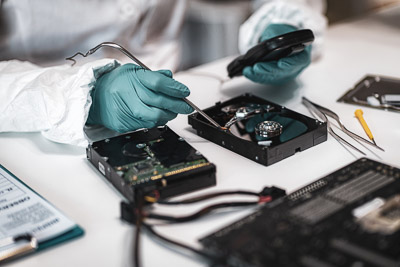The Rising Need for Digital Forensics
What is Digital Forensics?
According to US-CERT, Digital (Computer) Forensics can be defined “as the discipline that combines elements of law and computer science to collect and analyze data from computer systems, networks, wireless communications, and storage devices in a way that is admissible as evidence in a court of law.”[1] Digital forensics primarily deals with the process of collecting, analyzing, and documenting latent digital evidence. Digital forensics is a branch of forensic science and is often employed when digital evidence needs to be preserved for legal purposes.

Why is it necessary?
Having a Digital Forensic solution is an essential part of any enterprises’ cybersecurity program. Digital Forensics is a key pillar in the “Defense-in-Depth” approach to information security. Understanding the legal and technical aspects of computer forensics will help you capture vital information if your network/infrastructure is compromised and will assist in the prosecution of the responsible entities.
What’s the difference between incident response and digital forensics?
Digital Forensics can drive and augment incident response. Incident response efforts often leverage intelligent tools (e.g. Indicators of Compromise, signature rules, etc.) and are effective only when there is prior information about the vulnerabilities and mechanisms utilized in an attack. The effectiveness of these tools is inverse to the quantity of new and novel attack techniques and mechanisms utilized by threat actors. Digital forensic processes does not suffer from such issues, and can greatly improve and organizations resiliency and ability to recover from a cyber-incident. Additionally traditional IR efforts do not often preserve evidence in a fashion that would be admissible in a court setting.
What is eDiscovery?
Electronic discovery (eDiscovery) is a term referring to discovery process in legal proceedings. eDiscovery differs from traditional Discovery in that the information in question is in electronic/digital format (also known as ESI). Electronic discovery is dictated by rules of civil procedure and accomplished through formalized processes. Electronic information differs from paper information in various ways (intangible form, transient nature, persistence, etc.). and is usually accompanied by metadata (the preservation of which presents specific challenges)– and is of critical consideration when presenting digital information as evidence.
What is the Chain of Custody?
In Digital Forensics, the Chain of Custody is a process that documents the specifics of evidence collection (including the safeguarding, and analysis throughout its lifecycle) by notating each individual involved in the handling of evidence, when it was collected/transferred, and why it was collected/transferred.
Who is qualified to perform digital forensics?
A qualified digital forensic assessor must be proficient in multiple different domains of technical and administrative knowledge, this includes (but it not limited to) computer science, information assurance, information security, document control and review, metadata analysis, volatile memory extraction, etc.
Related Blog Posts

What to Expect for CMMC 2.0 Assessments
What to Expect for CMMC 2.0 Assessments So now you have put in all the work to meet the requirements of CMMC 2.0 level 1, 2, or 3, but what’s next? Once the rules are finalized and being implemented, companies will need to be able to certify that they are...

CMMC 2.0 Requirements: Level Three
CMMC Requirements: Level Three Now we enter the most nebulous category of CMMC 2.0 requirements: level three. While we know where the requirements will come from, we don’t know exactly how many will be added from the NIST 800-172 publication. While there are...

CMMC 2.0 Level 2 Requirements
CMMC 2.0 Level 2 CMMC 2.0 Level 2-that’s where things really start to get serious. While the controls required aren’t incredibly difficult, there are probably a fair number that most companies haven’t considered before, especially since there are 110 of them. And I am...

CMMC 2.0 Level 1 Requirements
We’re going to start digging through the CMMC levels, starting with CMMC 2.0 Level 1. I will go through the different protection areas and briefly describe what they mean. I don’t intend for this to be a complete guidance, but more an introduction to allow you to be...

Newsletter
Subscribe To Our Newsletter
We've been creating some excellent webinars and local events. Join our mailing list for the latest on industry trends and strategies for cyber defense.
Need Immediate Assistance?
Give us a call (405) 771-6399
Headquarters
3841 E Danforth Rd, Ste 106, Edmond, OK 73034
110 E. Houston St, 7th Floor, San Antonio, TX 78205
Copyright 2024 - Critical Fault, LLC. | Privacy Policy


